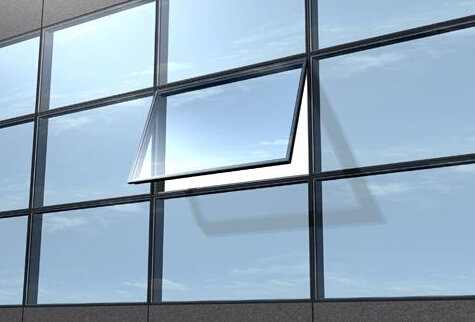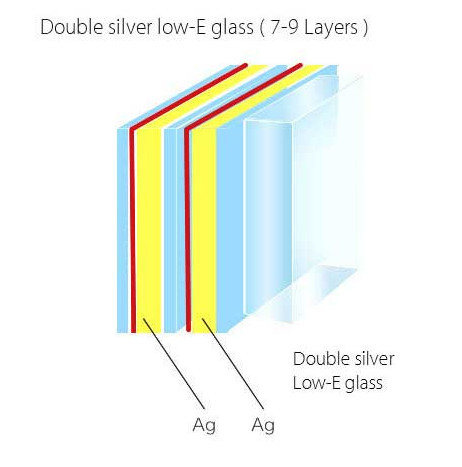Energy Saving Low-e Glasschina supplier and manufacturer. Jing Hai Glass factory is Building architectural glass china company of in Tempered Glass, Switchable Glass Smart Glass, Laminated Glass,Double-glazed Insulating glass, Hollow glass, Low-E glass, Double silver LOW E Glass, Three silver LOW E glass, Stained Glass, Etc.
Low-emissivity glass (or low-e glass as it is commonly referred to) is a type of energy-efficient glass designed to prevent heat escaping through your windows to the cold outdoors. Low-e coatings have been developed to minimize the amount of ultraviolet and infrared light that can pass through glass without compromising the amount of visible light that is transmitted.The use of low-e glazing helps to retain heat even in winter, allowing you to comfortably use these rooms for more months of the year.
Features of Energy Saving Low-e Glass:
• significantly improve your Window Energy Ratings and reduce the amount of energy lost through your windows by up to 75%;
• Insulated Glass can well insulate sound and lower self-weight of buildings;
• Sound proof, prevent the spread of voice, and reduce the noise;
Dimension Range
Min 300mm * 300mm;
Max 3200mm * 6000mm
Thickness
monolithic 3-19mm
insulated 12-60mm

Low Emissitivity Coating
Low-emissivity (low-E) coatings are microscopically thin metal layers that are deposited on a window surface to help keep heat on the same side of the glass from which it originated. Depending on the climate, and whether it's for commercial, residential or automotive use. Glass coated with a low-emissivity substance can reflect radiant infrared energy, encouraging radiant heat to remain on the same side of the glass from which it originated, while letting visible light pass. This often results in more efficient windows because radiant heat originating from indoors in winter is reflected back inside, while infrared heat radiation from the sun during summer is reflected away, keeping it cooler inside.


Low Emissitivity Insulating Glass
Insulating glass, or double glazing, consists of a window or glazing element of two or more layers of glazing separated by a spacer along the edge and sealed to create a dead air space between the layers. This type of glazing has functions of thermal insulation and noise reduction. When the space is filled with an inert gas it is part of energy conservation sustainable architecture design for low energy buildings.

Soft Coat Low E Glass (Sputtered Low-e glass vacuum deposition or soft coat)
Soft coat Low E, or sputter coating, is applied in multiple layers of optically transparent silver sandwiched between layers of metal oxide in a vacuum chamber. This process provides the highest level of performance and a nearly invisible coating.
Advantages of Energy Saving Low-e Glass
High visible light transmission
Ultra-low emissivities giving optimum winter U-values
Up to 70% less UV transmission compared with standard clear glazing
Optical clarity – minimal color haze
Disadvantages of Energy Saving Low-e Glass
Soft coat Low E must be used in a double glazed unit; the soft coating is sensitive to handling.
Most soft coat Low-E products require tempering the glass prior to the coating application.
Edge deletion of the coating is required to insure a proper seal in an insulated unit
There can be slight color variations of coating.
Generally speaking, a more expensive alternative than Hard Coat Low e glass.
Hard Coat Low E Glass (pyrolytic glass)
Advantages
The advantage is that the coating is relatively durable, which allows for ease of handling and tempering.
Can be toughened after the coating application.
Can be used in single glazing applications.
Utilizes passive solar heat gain.
Disadvantages
Higher U-values compared to soft coat Low-E products
Slightly higher haze levels
Higher solar heat gain coefficient compared to soft coat Low-E products.
Hard coat glass also has the possibility of a slight haze, which can be visible under certain angles.
APPLICATIONS of Energy Saving Low-e Glass
•Architectural interiors
•Facades
•Shop fronts
•Museums
•Panoramic restaurants
•Showrooms
•Luxury commercial decoration
•Stadiums/arenas
•Historical preservation
•Waiting rooms
•Display windows
•Design elements
•Partition walls
•Artwork
•Cash dispensers
•Petrol stations
•Display cases
•Balustrades
•Store fixtures
•Lobbies
•Foyers
•TV and recording studios
•Observation rooms
•Display units
•Internal partitions
•Interpreter / sound booths
•Zoos and aquariums
•Terrariums and vivariums
•Airports
•Control towers
•Bulletproof windows
| Construct | Refl Color | Visible Tans | Visible Reflect | Solar Heat | U Value | SC | |||
| indoor | outdoor | SHGC | relative HG | Winter | Summer | ||||
| 6+12A+6 with double silver coating on 2# surface | greyish blue | 40 | 14 | 31 | 0.26 | 202 | 1.62 | 1.55 | 0.3 |
| blue | 39 | 14 | 31 | 0.26 | 203 | 1.66 | 1.61 | 0.3 | |
| golden | 44 | 33 | 22 | 0.23 | 177 | 1.61 | 1.53 | 0.26 | |
| light blue | 50 | 25 | 23 | 0.25 | 195 | 1.64 | 1.58 | 0.29 | |
| neutral grey | 54 | 16 | 18 | 0.31 | 239 | 1.63 | 1.57 | 0.36 | |
| 6+12A+6 with triple silver coating on 2# surface | emerald green | 54 | 11 | 17 | 0.24 | 186 | 1.61 | 1.54 | 0.28 |
| light blue | 57 | 9 | 14 | 0.27 | 206 | 1.62 | 1.55 | 0.31 | |
| neutral grey | 60 | 11 | 15 | 0.27 | 202 | 1.62 | 1.55 | 0.31 | |
| neutral green | 67 | 13 | 15 | 0.31 | 234 | 1.61 | 1.54 | 0.35 | |
. Structural Glass Curtain Walls
. What is color! Simple Talking ...
. Advantages and uses of toughen...
. Various glass defects and solu...
Office Addr:Room 1107, B1 Block, Tianan Cyber,Nancheng Area, Dongguan City, Guangdong Province, China,
Factory Addr:Taiying Industrial, Hongmei Town, Dongguan City, Guangdong Province, China
86-769-22273585
86-18145870793
![]()